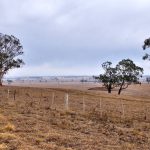 April 12, 2021 4:02 pm
Published by Climate Extremes
April 12, 2021 4:02 pm
Published by Climate Extremes
Until now, flash drought research has been on the regional scale and has been limited to observations and reanalyses. CLEX researchers have been the first to examine flash drought in climate models.
 December 14, 2020 11:01 am
Published by Climate Extremes
December 14, 2020 11:01 am
Published by Climate Extremes
A major component of the research in the Drought program over the past four months has focused on the interface between real-world data and climate models. The aim of much of this research has been to improve how land surface models represent some of the key processes that influence the length, and severity of drought.
 August 10, 2020 3:58 pm
Published by Climate Extremes
August 10, 2020 3:58 pm
Published by Climate Extremes
CLEX researchers and colleagues find soil moisture variations need to be considered over at least a decade before a steady-state assumption can be made.
 June 10, 2020 3:05 pm
Published by Climate Extremes
June 10, 2020 3:05 pm
Published by Climate Extremes
Researchers have developed a hybrid approach to estimate recent rainfall that combines satellite-based rainfall estimates with satellite-based soil moisture estimates. When this approach was tested against independent rain gauge measurements it showed notable improvements.
 February 8, 2019 11:17 am
Published by Climate Extremes
February 8, 2019 11:17 am
Published by Climate Extremes
This study illustrates how future uncertainty of climate models in predicting hot extremes is controlled by two factors, both related to amplification of hot extremes through land-atmosphere interactions
 December 18, 2018 1:20 pm
Published by Climate Extremes
December 18, 2018 1:20 pm
Published by Climate Extremes
By employing an atmosphere-only version of ACCESS, CLEX researchers generated multiple sea surface temperature patterns of the same El Nino and La Nina events, and assessed how this influenced heatwaves over various Australian regions.






